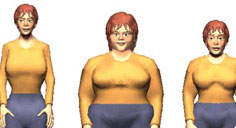News Center
News CenterComfortable Vehicle Designs for Everyone
Due to increased obesity, more of today's motorists are grappling with tighter fits around steering wheels, armrests and in seats.
To help us design vehicles that are comfortable for all our customers, we've developed an industry-first set of nine human Computer-Aided Design (CAD) virtual mannequins aimed at representing the population's more extreme body types and dimensions.
We're leveraging this technology to make our vehicles more comfortable—and more ergonomically appealing—for all our customers, including people of size.

Designing the Right Spaces
Our ergonomists use the CAD models to ensure our vehicles meet customer wants — like unprecedented amounts of storage space in front-seat consoles — while accommodating the greatest range of body types, which generally are growing taller and larger through the bust, hips and waistline.
For instance, our ergonomists used the virtual mannequins to evaluate the cabin of the all-new Ford Edge, assessing its ability to comfortably accommodate a variety of body shapes and sizes.
Measuring Up
In 2000, the Civilian American and European Surface Anthropometry Resource (CAESAR), a U.S. Air Force project supported by Ford, clothing, and other transportation companies, measured nearly 5,000 Americans and Europeans and scanned them from head to toe, both sitting and standing.
We used this data to create human CAD models, or virtual mannequins, some of whom represent high-BMI male and female models with wide hips and shoulders, long legs, short legs, long arms, short arms — and several combinations thereof. These mannequins can be positioned in and around vehicles, in various postures to examine their interaction with the surrounding environment.
Being able to view and manipulate these new mannequins in 3-D really allows us to get a better sense of how larger people are impacted by different factors when they enter, exit, sit in and operate different vehicles.
Related
-
Ford Crew Chief Telematics System Can Improve Fuel Economy by Up to 20 Percent Through Better Fleet Management
-
EMPHASIS ON CRAFTSMANSHIP, EXECUTION DEFINES 2011 LINCOLN MKX EXTERIOR DESIGN
-
VIBRANT, LUXURIOUS INTERIOR COMPLEMENTS 2011 LINCOLN MKX NEW DRIVER CONNECT TECHNOLOGY
-
ALL-NEW FORD EXPLORER OFFERS SURPRISING LEVEL OF CONVENIENCE, CONNECTIVITY TECHNOLOGIES







Connect With Ford
Ford Motor Company on Facebook
Ford Motor Company on YouTube
Follow @Ford on Twitter
Ford Motor Company on Flickr